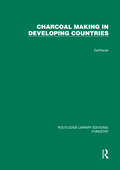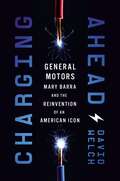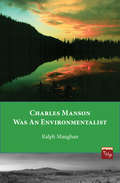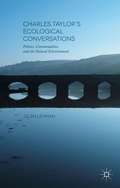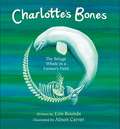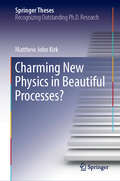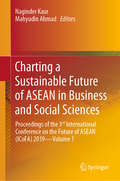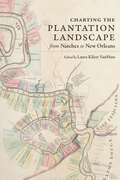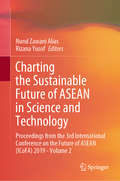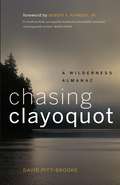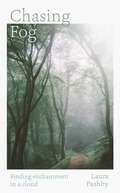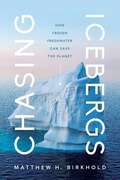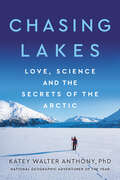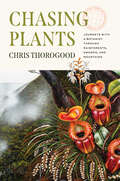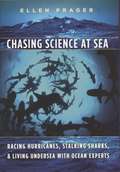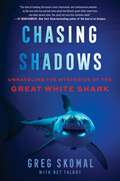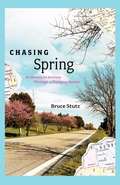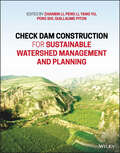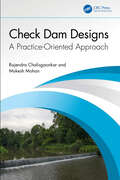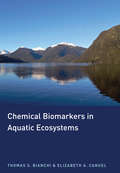- Table View
- List View
Charcoal Making in Developing Countries (Routledge Library Editions: Forestry)
by Gerald FoleyOriginally published in 1986, this book provides a detailed examination of programmes to introduce improved charcoal making techniques throughout the developing world. Charcoal making is widely regarded as an extremely wasteful use of scarce wood resources. The book includes a section on the physics and chemistry of charcoal and descriptions of the various traditional methods of charcoal making. Patterns of charcoal supply and distribution are analysed and efforts to introduce improved charcoal making techniques are described and evaluated.
Charge Transport in Low Dimensional Semiconductor Structures: The Maximum Entropy Approach (Mathematics in Industry #31)
by Vittorio Romano Vito Dario Camiola Giovanni MascaliThis book offers, from both a theoretical and a computational perspective, an analysis of macroscopic mathematical models for description of charge transport in electronic devices, in particular in the presence of confining effects, such as in the double gate MOSFET. The models are derived from the semiclassical Boltzmann equation by means of the moment method and are closed by resorting to the maximum entropy principle. In the case of confinement, electrons are treated as waves in the confining direction by solving a one-dimensional Schrödinger equation obtaining subbands, while the longitudinal transport of subband electrons is described semiclassically. Limiting energy-transport and drift-diffusion models are also obtained by using suitable scaling procedures. An entire chapter in the book is dedicated to a promising new material like graphene. The models appear to be sound and sufficiently accurate for systematic use in computer-aided design simulators for complex electron devices. The book is addressed to applied mathematicians, physicists, and electronic engineers. It is written for graduate or PhD readers but the opening chapter contains a modicum of semiconductor physics, making it self-consistent and useful also for undergraduate students.
Charging Ahead: GM, Mary Barra, and the Reinvention of an American Icon
by David WelchMary Barra&’s quest to move GM to a manufacturer of electric cars has captured the attention of automobile aficionados, green-business advocates, and leaders of all types who have to admire Mary&’s toughness in moving forward despite the overwhelming obstacles in her path.A decade ago, no one would have guessed that GM would be the company poised to lead America into the future. At a time when business book readers seem endlessly fascinated by soaring tech giants like Amazon and Netflix, and ill-fated startups like WeWork and Theranos, why is it important to put the spotlight back on 112-year-old GM? Because Charlie Wilson&’s quip from 1952 is still true: What&’s good for GM is still good for America, and vice versa. America needs to transition to a new era of clean energy and environmentally sustainable transportation. We also need to adapt to a world with far fewer assembly-line jobs, but far more skilled jobs for people who can design, build, and operate robots and other high-tech machines. GM&’s attempt to lead those transitions is as important as it is dramatic.Equally compelling is the story of GM&’s CEO, Mary Barra, who against all odds took the reins at GM in 2014. Since that time, she has attempted to reinvent a century-old company and equip it for the biggest change in transportation since the internal combustion engine replaced the horse. In the process, she has been ripping out GM traditions by the roots—and taking flak from all sides. Her plan is to make GM—the company famed for the gas-burning Corvette, hulking Cadillac Escalade, and carbon-spewing Silverado pickup—purely electric and clean by 2035. She may not be as wealthy as Jeff Bezos, as brash as Elon Musk, or as powerful as Mark Zuckerberg, but Mary Barra is just as important as any of them. And as one of the most powerful female executives in the world, she is overdue for an in-depth look at her forward-thinking vision, her approach to leadership, and her accomplishments against the odds.
Charles Manson was an Environmentalist
by Ralph MaughanIn the fall of 1979, millions of some of the most beautiful acres in the world were under threat. The political heat surrounding the environmental controversy prompted then Senator Frank Church to wear a bullet proof vest to public hearings. This is Ralph Maughan's personal story of the courageous creation of the Frank Church - River of No Return Wilderness.
Charles Olivier and the Rise of Meteor Science (Springer Biographies)
by Richard TaibiThis fascinating portrait of an amateur astronomy movement tells the story of how Charles Olivier recruited a hard-working cadre of citizen scientists to rehabilitate the study of meteors. By 1936, Olivier and members of his American Meteor Society had succeeded in disproving an erroneous idea about meteor showers. Using careful observations, they restored the public's trust in predictions about periodic showers and renewed respect for meteor astronomy among professional astronomers in the United States. Charles Olivier and his society of observers who were passionate about watching for meteors in the night sky left a major impact on the field. In addition to describing Olivier's career and describing his struggles with competitive colleagues in a hostile scientific climate, the author provides biographies of some of the scores of women and men of all ages who aided Olivier in making shower observations, from the Leonids and Perseids and others. Half of these amateur volunteers were from 13 to 25 years of age. Their work allowed Olivier and the AMS to contradict the fallacious belief in stationary and long-enduring meteor showers, bringing the theory of their origin into alignment with celestial mechanics. Thanks to Olivier and his collaborators, the study of meteors took a great leap forward in the twentieth century to earn a place as a worthy topic of study among professional astronomers.
Charles Taylor’s Ecological Conversations: Politics, Commonalities And The Natural Environment
by Glen LehmanThe author uses the work of the eminent Canadian philosopher, Charles Taylor, to develop a critique of those political perspectives that are based on instrumental ways to reason about the world, claiming that such perspectives invariably sever the connections between the social and natural worlds.
Charlotte's Bones: The Beluga Whale In A Farmer's Field (Tilbury House Nature Book #0)
by Erin Rounds Alison CarverMany thousands of years ago, when a sheet of ice up to a mile thick began to let go of the land, the Atlantic Ocean flooded great valleys that had been scooped out by glaciers, and the salty waves of an inland sea lapped the green hills of Vermont. Into this arm of the sea swam Charlotte. Her milky, smooth, muscled body sliced slowly through the water like scissors through silk. Like a chirping canary, her voice echoed across dark waters showing the way to her pod as belugas have done for millions of years. In 1849, a crew building a railroad through Charlotte, Vermont, dug up strange and beautiful bones in a farmer’s field. A local naturalist asked Louis Agassiz to help identify them, and the famous scientist concluded that the bones belonged to a beluga whale. But how could a whale’s skeleton have been buried so far from the ocean? The answer—that Lake Champlain had once been an arm of the sea—encouraged radical new thinking about geological time scales and animal evolution. Charlotte’s Bones is a haunting, science-based reconstruction of how Charlotte died 11,000 years ago in a tidal marsh, how the marsh became a field, how Charlotte found a second life as the Vermont state fossil, and what messages her bones whisper to us now about the fragility of life and our changing Earth. Lexile 940; F&P Level P
Charm Production in Deep Inelastic Scattering: Mellin Moments of Heavy Flavor Contributions to F2(x,Q^2) at NNLO (Springer Theses)
by Sebastian KleinThe production of heavy quarks in high-energy experiments offers a rich field to study, both experimentally and theoretically. Due to the additional quark mass, the description of these processes in the framework of perturbative QCD is much more demanding than it is for those involving only massless partons. In the last two decades, a large amount of precision data has been collected by the deep inelastic HERA experiment. In order to make full use of these data, a more precise theoretical description of charm quark production in deep inelastic scattering is needed. This work deals with the first calculation of fixed moments of the NNLO heavy flavor corrections to the proton structure function F2 in the limit of a small charm-quark mass. The correct treatment of these terms will allow not only a more precise analysis of the HERA data, but starting from there also a more precise determination of the parton distribution functions and the strong coupling constant, which is an essential input for LHC physics. The complexity of this calculation requires the application and development of technical and mathematical methods, which are also explained here in detail.
Charming New Physics in Beautiful Processes? (Springer Theses)
by Matthew John KirkThis PhD thesis is dedicated to a subfield of elementary particle physics called “Flavour Physics”. The Standard Model of Particle Physics (SM) has been confirmed by thousands of experimental measurements with a high precision. But the SM leaves important questions open, like what is the nature of dark matter or what is the origin of the matter-antimatter asymmetry in the Universe. By comparing high precision Standard Model calculations with extremely precise measurements, one can find the first glimpses of the physics beyond the SM – currently we see the first hints of a potential breakdown of the SM in flavour observables. This can then be compared with purely theoretical considerations about new physics models, known as model building. Both precision calculations and model building are extremely specialised fields and this outstanding thesis contributes significantly to both topics within the field of Flavour Physics and sheds new light on the observed anomalies.
Charting a Sustainable Future of ASEAN in Business and Social Sciences: Proceedings of the 3ʳᵈ International Conference on the Future of ASEAN (ICoFA) 2019—Volume 1
by Naginder Kaur Mahyudin AhmadThis volume showcases selected conference papers addressing the sustainable future of ASEAN from the perspectives of business and social science disciplines. In addressing the 17 Sustainable Developments Goals (SDGs) envisioned by the United Nations in the domains of environment, health and well-being, posing potential means of reducing inequalities globally, the authors target specific issues and challenges confronting the fast-growing region of ASEAN and present suggestions for co-operation and commitment from governments, non-governmental organisations (NGOs) and society at large, in line with the ASEAN Vision 2020. Papers are selected from the 3rd International Conference on the Future of ASEAN (ICoFA) 2019, organised by Universiti Teknologi MARA in Malaysia, whose conference theme “Charting the Sustainable Future of ASEAN” enables intellectual discourse on sustainability issues from business and the social sciences, as well as science and technology. The selection of papers is published in two volumes, comprising scholarly and practical insights into sustainability in ASEAN. This first volume of papers from business and social science scholars will be of interest to researchers and policymakers interested in sustainability developments in the ASEAN region.
Charting the Plantation Landscape from Natchez to New Orleans (Reading the American Landscape)
by Laura Kilcer VanHussCharting the Plantation Landscape from Natchez to New Orleans examines the hidden histories behind one of the nineteenth-century South’s most famous maps: Norman’s Chart of the Lower Mississippi River, created by surveyor Marie Adrien Persac before the Civil War and used for decades to guide the pilots of river vessels. Beyond its purely cartographic function, Persac’s map depicted a world of accomplishment and prosperity, while concealing the enslaved and exploited laborers whose work powered the plantations Persac drew. In this collection, contributors from a variety of disciplines consider the histories that Persac’s map omitted, exploring plantations not as sites of ease and plenty, but as complex legal, political, and medical landscapes.Essays by Laura Ewen Blokker and Suzanne Turner consider the built and designed landscapes of plantations as they were structured by the logics and logistics of both slavery and the effort to present a façade of serenity and wealth. William Horne and Charles D. Chamberlain III delve into the political activity of formerly enslaved people and slaveholders respectively, while Christopher Willoughby explores the ways the plantation health system was defined by the agro-industrial environment. Jochen Wierich examines artistic depictions of plantations from the antebellum years through the twentieth century, and Christopher Morris uses the famed Uncle Sam Plantation to explain how plantations have been memorialized, remembered, and preserved.With keen insight into the human cost of the idealized version of the agrarian South depicted in Persac’s map, Charting the Plantation Landscape encourages us to see with new eyes and form new definitions of what constitutes the plantation landscape.
Charting the Sustainable Future of ASEAN in Science and Technology: Proceedings from the 3rd International Conference on the Future of ASEAN (ICoFA) 2019 - Volume 2
by Nurul Zawani Alias Rizana YusofThis book showcases selected conference papers addressing the sustainable future of ASEAN from the perspectives of science and technology disciplines. In addressing the 17 Sustainable Developments Goals (SDGs) envisioned by the United Nations in the domains of environment, health and well-being, posing potential means of reducing inequalities globally, the authors target specific issues and challenges confronting the fast-growing region of ASEAN and present suggestions for co-operation and commitment from governments, non-governmental organisations (NGOs) and society at large, in line with the ASEAN Vision 2020. Papers are selected from the 3rd International Conference on the Future of ASEAN (ICoFA) 2019, organised by Universiti Teknologi MARA in Malaysia, whose conference theme “Charting the Sustainable Future of ASEAN” enables intellectual discourse on sustainability issues from science and technology, as well as business and the social sciences. The selection of papers is published in two books, comprised of scholarly and practical insights on sustainability in ASEAN. This book from science and technology scholars is of interest to researchers and policymakers interested in sustainability developments in the ASEAN region.
Charting the World: Geography and Maps from Cave Paintings to GPS with 21 Activities (For Kids series)
by Richard PanchykMaps have been a part of human culture since the days of scratching on cave walls, and this richly illustrated history chronicles the road from simple diagrams used to avoid danger to the complex, navigational charts used today. Displaying an array of historic atlases and a variety of cartography styles, this book allows young readers to test their map-reading skills while discovering the intricate beauty and the wealth of information held within. Geographical concepts are spotlighted through an assortment of guided activities--including finding the elevation of hills, plotting a course with a magnetic compass, creating three-dimensional land models using a contour map, and performing a plot survey. Drawing the conclusion that the study of geography and maps is crucial to understanding an ever-changing planet, this handbook discloses the ways in which technological advances in cartography can further discussions on climate change, warfare, environmental conservation, population growth, and other timely topics.
Chasing Clayoquot
by Robert F. Kennedy Jr. David Pitt-BrookeFirst published in 2004, and now with a new introduction by the author and a foreword by Robert F. Kennedy Jr., this book of natural history, environmentalism, and politics explores one of the Earth's last primeval places: Clayoquot Sound. Pitt-Brooke takes the reader on 12 journeys, one for each month of the year. Each journey covers the outstanding natural event of that season, such as whale-watching in April, shorebird migration in May, and the salmon spawn in October.
Chasing Fog: Finding Enchantment in a Cloud
by Laura PashbyAt first, I didn&’t find fog – fog found me. Liminal, transformative and increasingly elusive – far from a simple cloud of water droplets, fog is a state of mind. As mist drifted through a copse of trees, turning a familiar place strange and otherworldly, Laura Pashby snapped a photograph and an obsession began. Pashby hunts for fog, walks and swims in it, explores its often pivotal role in literature, mythology and history, as well as its environmental significance. There has been a 50 per cent drop in 'fog events' in the past fifty years, fog is drifting away without us noticing and the ecological impact could be calamitous. As she journeys to the foggiest places she can find, Pashby immerses herself in Dartmoor&’s dangerous fog, searches for the Scottish haar, experiences Venice&’s magical mist, tell us the myths behind the River Severn&’s fog and the shipwrecks it hides. It&’s easy to get lost in fog, but sometimes it&’s where imperceptible things can be found, including in ourselves. Chasing Fog is a captivating meditation on fog and mist, a love song to weather and nature&’s power to transform.
Chasing Icebergs: How Frozen Freshwater Can Save the Planet
by Matthew H. BirkholdA deeply intelligent and engrossing narrative that will transform our relationship with water and how we view climate change.The global water crisis is upon us. 1 in 3 people do not have access to safe drinking water; nearly 1 million people die each year as a result. Even in places with adequate freshwater, pollution and poor infrastructure have left residents without basic water security. Luckily, there is a solution to this crisis where we least expect it. Icebergs—frozen mountains of freshwater—are more than a symbol of climate change. In his spellbinding Chasing Icebergs, Matthew Birkhold argues the glistening leviathans of the ocean may very well hold the key to saving the planet. Harvesting icebergs for drinking water is not a new idea. But for the first time in human history, doing so on a massive global scale is both increasingly feasible and necessary for our survival. Chasing Icebergs delivers a kaleidoscopic history of humans&’ relationship with icebergs, and offers an urgent assessment of the technological, cultural, and legal obstacles we must overcome to harness this freshwater resource. Birkhold takes readers around the globe, introducing them to a colorful cast of characters with wildly different ideas about how (and if) humans should use icebergs. Sturdy bureaucrats committed to avoiding another Titanic square off against &“iceberg cowboys&” who wrangle the frozen beasts for profit. Entrepreneurs selling luxury iceberg water for an eye-popping price clash with fearless humanitarians trying to tow icebergs across the globe to eradicate water shortages. Along the way, we meet some of the world&’s most renowned scientists to determine how industrial-scale iceberg harvesting could affect the oceans and the poles. And we see firsthand the looming conflict between Indigenous peoples like the Greenlandic Inuit with claims to icebergs and the private corporations that stand to reap massive profits. As Birkhold shepherds readers from Connecticut to South Africa, from Newfoundland to Norway, to Greenland and beyond, he unfurls a visionary argument for cooperation over conflict. It&’s not too late for icebergs to save humanity. But we must act fast to form a coalition of scientists, visionaries, engineers, lawyers and diplomats to ensure that the &“Cold Rush&” doesn&’t become a free-for-all.
Chasing Lakes: Love, Science, and the Secrets of the Arctic
by Katey Walter AnthonyAn aquatic ecologist and permafrost scientist recalls her captivating adventures across the Arctic studying climate change, her quest to find belonging and family, and her journey of faith in a world of science in this poignant, eye-opening, and hopeful memoir in the spirit of Lab Girl, Educated, and Finding the Mother Tree.Katey Walter Anthony’s enchantment with lakes began when she was growing up amid the Sierra Nevada mountains. Today, her love for these bodies of water have taken her to the deepest reaches of Alaska and Siberia, where she is undertaking pioneering research on methane emissions. Chasing Lakes is her story: one-part adventure—complete with shipwrecks and treacherous treks through Arctic storms by helicopter, snowmobile, and foot to measure greenhouse gases—part coming-of-age tale, as she searches for belonging in the wake of a broken childhood, and part spiritual quest to find a wholeness science cannot fill.Somewhere between the remote, frozen landscapes of Siberia and her rough cabin in Alaska, she discovers her spiritual and emotional home when she meets Peter, a bright and humble Minnesota farmer who reinvigorates her faith and helps ground her. Yet finding love and fulfillment brings its own challenges. The closer she gets to having the family she’s always wanted, the further she’s pushed from the important field work that is her passion.Chasing Lakes is a chronicle of a woman seeking truth, adventure, scientific discovery, family, love, and grace. Both an eye-opening look from the frontlines of the climate crisis and an intimate portrait of a brilliant scientist, Chasing Lakes is memoir writing at its finest: beautiful, complex, revelatory, and moving.
Chasing Plants: Journeys with a Botanist through Rainforests, Swamps, and Mountains
by Chris ThorogoodA New Scientist Best Book of the Year From an acclaimed botanist and artist, a thrilling and beautifully illustrated expedition around the globe in search of the world’s most extraordinary plants. After making a strange discovery on a childhood trip to Ikea—a stand of sap-sucking, leafless broomrapes, stealing nutrients from their neighbors’ roots—Chris Thorogood dreamed of becoming a botanist and would stop at nothing to feed his growing addiction to plants. In his hair-raising adventures across Europe, Africa, the Middle East, and Asia, Thorogood treads a death-defying path over cliffs, up erupting volcanoes, through typhoons, and out into the very heart of the world’s vast, green wilderness. Along the way, he encounters pitcher plants, irises, and orchids more heart-piercingly beautiful than could ever be imagined. But with Thorogood as our guide in Chasing Plants, we not only imagine: we see. An internationally acclaimed botanical illustrator, Thorogood conjures his adventures spent seed-collecting and conserving plants around the world back to life in his electric paintings, which feature throughout the book. They bring plants out of the shadows, challenging us to see their intrigue and their character, and helping us to understand why plant species must be protected. To join Thorogood in his wild adventures is to be cast under his green spell: readers will never think of plants the same way again.
Chasing Science at Sea: Racing Hurricanes, Stalking Sharks, and Living Undersea with Ocean Experts
by Ellen PragerTo the average office-dweller, marine scientists seem to have the good life: cruising at sea for weeks at a time, swimming in warm coastal waters, living in tropical paradises. But ocean scientists who go to sea will tell you that it is no vacation. Creature comforts are few and the obstacles seemingly insurmountable, yet an abundance of wonder and discovery still awaits those who take to the ocean. With passion and wit, well-known marine scientist Ellen Prager shares her stories as well as those of her colleagues, revealing that in the field ingenuity and a good sense of humor are as essential as water, sunblock, and a GPS. Serendipity is invaluable, and while collecting data is the goal, sometimes just getting back to shore means success. But despite the physical hardship and emotional duress that come with the work, optimism and adventure prompt a particularly hardy species of scientist to return again and again to the sea. Filled with firsthand accounts of the challenges and triumphs of dealing with the extreme forces of nature and the unpredictable world of the ocean, "Chasing Science at Sea" is a unique glimpse below the water line at what it is like and why it is important to study, explore, and spend time in one of our planet's most fascinating and foreign environments.
Chasing Shadows: My Life Tracking the Great White Shark
by Greg Skomal Ret Talbot“At last: the story of tracking the ocean’s most charismatic and controversial predator, compellingly told by the man who has learned more about the Atlantic great white shark than any other person alive. You must not miss this fantastic book!” —Sy Montgomery, New York Times bestselling author of The Soul of an OctopusDr. Greg Skomal, one of the leading great white shark experts in the country, reveals the true nature of these mysterious apex predators, as well as the fascinating story behind their history and startling resurgence With its quaint villages, local restaurants serving up lobster rolls, and miles and miles of warm, sandy beaches, Cape Cod, Massachusetts, is famous for being America’s carefree seaside getaway. But in August 2012, the first confirmed white shark attack in almost eighty years occurred in the region. As shark sightings quickly began to increase on Cape Cod and elsewhere, and large beachside billboards warning about the growing shark population became a common sight, a boogie boarder died after being attacked by a great white shark in Cape Cod’s shallow waters. What had changed to cause news of human-shark interactions to go from being a rarity to being the new normal? As some citizens called for shark culls, nets, drone surveillance, and other extreme solutions, interactions between local residents and scientists, politicians, and those responsible for public safety became tense and frantic. Dr. Greg Skomal, a shark biologist whose lifelong passion has been to gain a more refined understanding of great white sharks, was at the center of it all. This is the story of the great white shark’s return to the eastern seaboard, told through the life of the scientist who found himself in the oftentimes thankless position of having to balance conservation efforts and the drive to do important science with panic and fear in the court of public opinion. Greg has spent decades on a quest to tag, track, and demystify this animal, using every high- and low-tech method at his disposal, including those he invented, and he frequently comes face-to-face with these shadows of the deep. He leaves no stone unturned in his pursuit of the secrets behind the largely unknown lives of these charismatic creatures and in his duty to solve the intricate puzzle of how humans can coexist alongside them. Chasing Shadows is a too-rare conservation success story about restoring an apex predator to an ecosystem that provides a profound, new understanding of a beast so notoriously fierce that it’s nearly impossible to imagine how vulnerable it truly is.
Chasing Spring: An American Journey Through a Changing Season
by Bruce StutzIn the tradition of Blue Highways and Silent Spring, Chasing Spring follows nature's season of renewal even as it shows how the delicate mechanisms of spring are increasingly endangered by climate change. Seeking to revive his body and soul following heart surgery, acclaimed nature writer Bruce Stutz set out on a three-month journey through the unfolding of an American spring. Driving across the country in a twenty-year-old Chevy sedan, Stutz shows readers that spring is not so much a progression as an arousal; each added minute of the lengthening days and lingering sun brings yet another transformation in the greening landscape as well as in the human spirit. Beginning with the season's southernmost stirrings along the Gulf of Mexico, Stutz sees the first blooms and partakes in the season's festivals -- celebrations with ancient origins that still speak to our wonder at nature's annual rebirth. He follows the migrations of birds northward, the return of life to the forests, and the quickening of snowmelt in the Rockies. He moves across the southern desert, encountering the explosion of cacti and wildflowers and the violence of tornadoes on the drought-stricken Great Plains. He then travels north through the national parks of the West, finally celebrating his journey's end by basking at the solstice amid the beauty of the Alaskan Arctic's twenty-four hours of daylight. Along the way, he accompanies scientists into the field to study the season's changes and meets farmers, Arctic natives, and even migrant mushroom pickers whose livelihoods depend on the coming of spring. In each location, as he observes the sensitive interplay of light and warmth that draws animals, plants, water, and even the soil itself into the biological ballet that makes for the profound stirring we call spring, he also finds that climate change now threatens the basic processes of nature. A moving and thought-provoking record of the year¹s most invigorating season, Chasing Spring is a timely reminder that as trees bud and flowers bloom, the human spirit reawakens as well. Anyone who has ever marveled at spring¹s wondrous transformations?from a first garden blossom to a world in full flower?will find in Chasing Spring a journey to savor.
Check Dam Construction for Sustainable Watershed Management and Planning
by Peng Shi Peng Li Yang Yu Zhanbin Li Guillaume PitonCHECK DAM CONSTRUCTION FOR SUSTAINABLE WATERSHED MANAGEMENT AND PLANNING Authoritative and comprehensive reference on the potential for watershed development through the use of check dams Check Dam Construction for Sustainable Watershed Management and Planning summarizes current knowledge of check dams as key soil and water conservation structures in some of the most sensitive and vulnerable ecosystems in the world, as exemplified by the Mediterranean area and the Chinese Loess Plateau, providing detailed information on check dam design and watershed planning, the use of advanced modeling techniques, challenges in dam construction and how to overcome them. The work integrates decades of research in the field of soil and water conservation and gully management, including advanced studies in check dam construction and watershed management. It also covers important new techniques and methods, such as hydrological modeling, isotope tracing, and more. To aid in reader comprehension, the five highly qualified editors have divided the work into three distinct sections. Sections I and II focus on the experience gained from the erosion hotspots in the Chinese Loess Plateau, whereas Section III expands the scope to other regions with different functions for check dams, including headwater ecosystems and alpine environments. Sample topics covered in Check Dam Construction for Sustainable Watershed Management and Planning include: The regulating effect of check dam systems on sediment redistribution and the formation and development of dam systems in small watersheds Water and soil conservation made possible by check dam construction and sediment source analysis of water-sediment retarding effects of check dams The regulation of check dam systems on the erosion dynamic process and the mechanism of erosion reduction by check dams Flood control risk assessment on warping dam systems and the development and utilization model of check dam systems With its systematic coverage of all aspects of dam construction and maintenance, Check Dam Construction for Sustainable Watershed Management and Planning supports decision making by local authorities and can also be used as a professional guide for ecologists, hydrologists, and water resource managers.
Check Dam Designs: A Practice-Oriented Approach
by Rajendra Chalisgaonkar Mukesh MohanCheck dams are small barriers built across the direction of water flow on shallow rivers and streams for the purpose of water harvesting. This book is a review of basic principles and practice-oriented approaches for check dam designs. It offers a hands-on approach with a strong, practical bias helpful in solving problems that are likely to be encountered in real-life field situations. It has been divided into nine chapters dealing with design details for gabion, masonry, concrete, and rubber check dams, including briefs about topographical surveys and geotechnical and hydrological investigations.Features: Gives insight into the principles of design and construction of check dams. Includes data assumptions and design principles along with design philosophy. Discusses design of gabion, masonry, and concrete check dams. Contains illustrative examples along with 20 engineering drawings and 140 quick solution tables for design of gabion, masonry, and concrete check dams. Explores easy-to-use tables for design of masonry and concrete retaining walls. This book is aimed at professionals, students, researchers, and practitioners in civil engineering, hydrology, and water conservation.
Chelyabinsk Superbolide (Springer Praxis Books)
by Nick Gorkavyi Alexander Dudorov Sergey TaskaevOn February 15, 2013, the Chelyabinsk meteor sailed over Russian skies in a streak of light that was momentarily brighter than the Sun. The remarkable event and its subsequent shock wave were witnessed and documented by countless local residents, launching a widespread scientific expedition to gather and study the remaining meteoritic fragments.This book chronicles Chelyabinsk’s tale of recovery and discovery from the minds of many of the scientists who studied the superbolide, leading field experiments and collecting meteorites and meteorite dust across the region. The Chelyabinsk superbolide is a complex and multi-aspect phenomenon. The book not only presents the results of the scientific research but also details the firsthand experiences of those involved in such efforts, providing readers with a unique opportunity to look at the "inner workings" of science that are seldom shown to the public.Over the course of their studies, the scientists collected over 200 photographs and a dozen video recordings taken by nearly 40 different eyewitnesses. Many of those never-before-published illustrations and photos can be found in full color in the pages of this book.
Chemical Biomarkers in Aquatic Ecosystems
by Thomas S. Bianchi Elizabeth A. CanuelThis textbook provides a unique and thorough look at the application of chemical biomarkers to aquatic ecosystems. Defining a chemical biomarker as a compound that can be linked to particular sources of organic matter identified in the sediment record, the book indicates that the application of these biomarkers for an understanding of aquatic ecosystems consists of a biogeochemical approach that has been quite successful but underused. This book offers a wide-ranging guide to the broad diversity of these chemical biomarkers, is the first to be structured around the compounds themselves, and examines them in a connected and comprehensive way. This timely book is appropriate for advanced undergraduate and graduate students seeking training in this area; researchers in biochemistry, organic geochemistry, and biogeochemistry; researchers working on aspects of organic cycling in aquatic ecosystems; and paleoceanographers, petroleum geologists, and ecologists. Provides a guide to the broad diversity of chemical biomarkers in aquatic environments The first textbook to be structured around the compounds themselves Describes the structure, biochemical synthesis, analysis, and reactivity of each class of biomarkers Offers a selection of relevant applications to aquatic systems, including lakes, rivers, estuaries, oceans, and paleoenvironments Demonstrates the utility of using organic molecules as tracers of processes occurring in aquatic ecosystems, both modern and ancient
